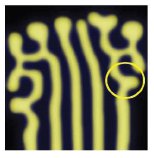| Turing's Biological Pattern Theory Proved |
| Written by Sue Gee |
| Thursday, 23 February 2012 |
|
In Alan Turing's Centenary Year, a team of researchers from King's College London is investigating one of his less-well known hypotheses and have demonstrated his theory of morphogenesis which has implications for future stem cell research. As well as inventing a lot of the modern theory of computability and doing a spot of code breaking, Alan Turing also did ground breaking work in AI and computational biology. He was fascinated by morphogenesis - the process by which cells organize themselves into the familiar shapes and patterns that we expect animals and plants to adopt. Turing, in 1951, invented a clever chemical scheme that would create a range of biological looking patterns using nothing but a two component chemical reaction. The original paper is well worth reading even today: It is suggested that a system of chemical substances, called morphogens, reacting together and diffusing through a tissue, is adequate to account for the main phenomena of morphogenesis... The investigation is chiefly concerned with the onset of instability. It is found that there are six essentially different forms which this may take. In the most interesting form stationary waves appear on the ring. It is suggested that this might account, for instance, for the tentacle patterns on Hydra and for whorled leaves. The basic idea is that you have two chemicals - one an activator and the other an inhibitor. You can write programs that simulate such a system and, yes, you do get pretty patterns that look biological out of the programs. However apart from appealing to the fact that the patterns look the same in the simulation and the biological system there have been no demonstrations that prove that the proposed mechanism is in fact the cause of the biology.
Now researchers from King's College London have provided experimental evidence confirming that two "morphogens", reacting as described by Turing, are responsible for the regularly spaced ridges found in the roof of the mouth of mice. The specific morphogens involved are – FGF (Fibroblast Growth Factor) and Shh (Sonic Hedgehog – so-called because laboratory fruit flies lacking the fly version have extra bristles on their bodies). They showed that when these morphogens' activity is increased or decreased, the pattern of the ridges in the mouth palate are affected in ways predicted by Turing's equations. For the first time the actual morphogens involved in this process have been identified and the team saw the effects predicted by Turing's 60-year-old speculative theory. You can see Dr Jeremy Green from the Department of Craniofacial Development at King's Dental Institute explaining the research in the following video:
Not only does this prove Turing's insight in his centenary year, but it might have practical applications in the future in manipulating stem cell regenerative techniques. More InformationThe chemical basis of morphogenesis, Turing 1951 New mechanism of pattern formation in vertebrate development Letter by Andrew Economou et al in Nature Genetics. Related Articles
Comments
or email your comment to: comments@i-programmer.info
To be informed about new articles on I Programmer, subscribe to the RSS feed, follow us on Google+, Twitter, Linkedin or Facebook or sign up for our weekly newsletter.
|
| Last Updated ( Thursday, 23 February 2012 ) |
 A typical bifurcation characteristic of a Turing process
A typical bifurcation characteristic of a Turing process
